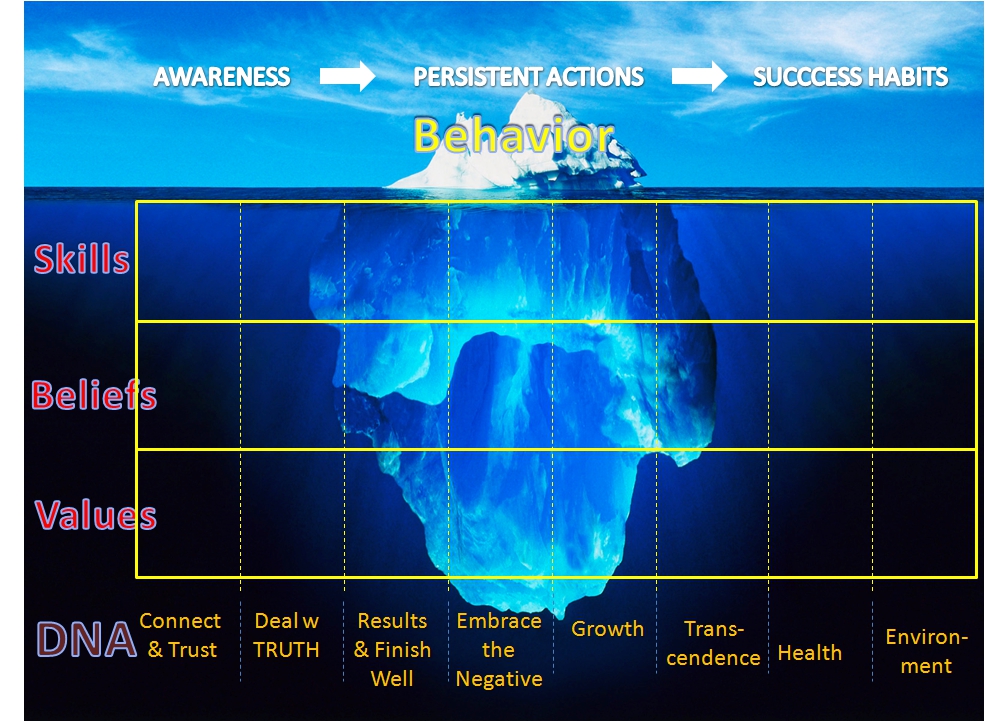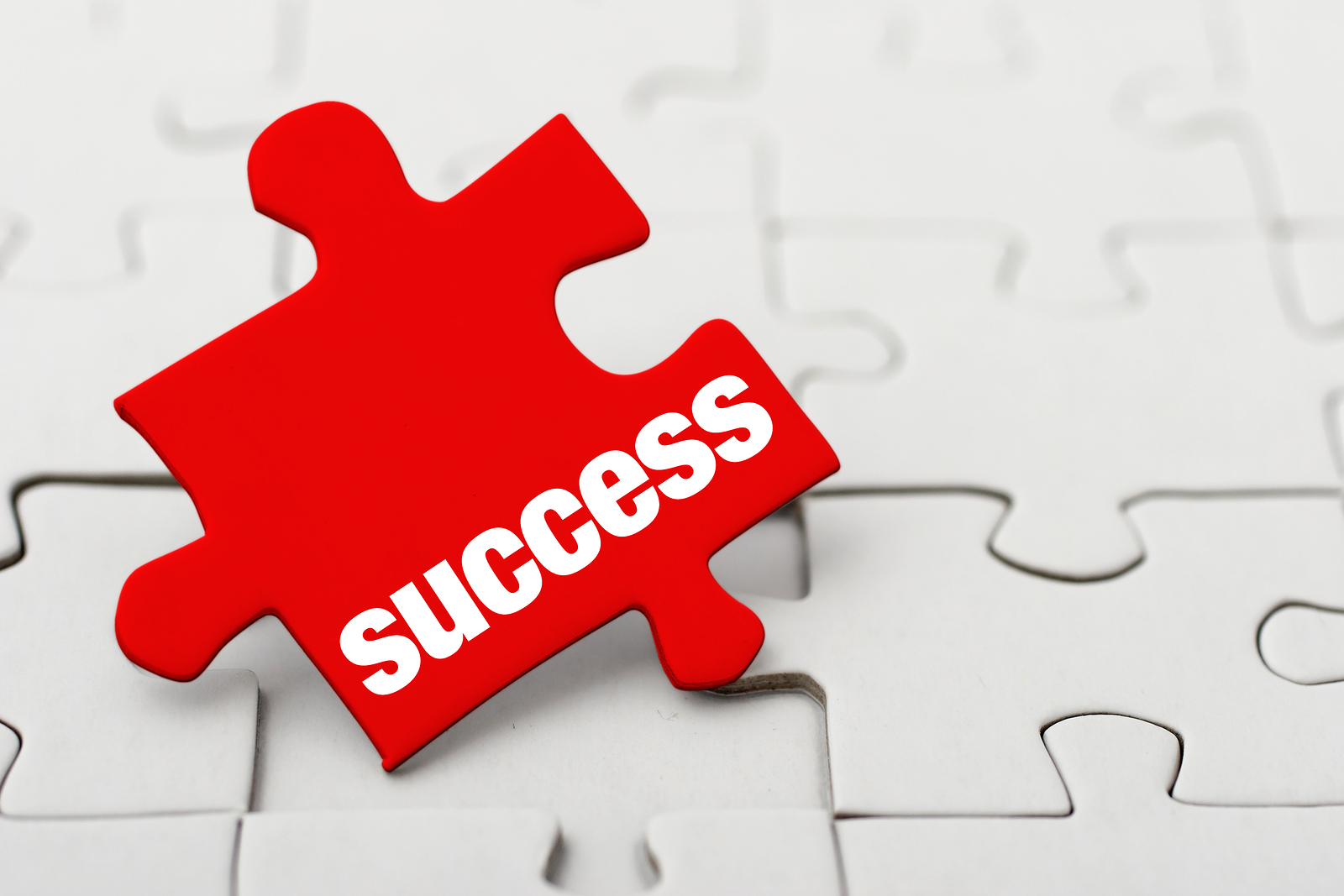Improve yourself using the Success Matrix
In the previous 10 blogs we described how in order to create success habits, we first must understand the multi-dimensional nature of our thinking. We described eight distinctively different dimensions of the Human Character and posed that we have different ‘Deserve Levels’ on each of them, leading to us being set into a certain behavior. After that, we described changing our thinking from an entirely different angle: the concept of the relative amount of effort that it requires to change our thinking, which we called ‘Identity Iceberg’. Today we will reveal the Success Matrix.
The Success Matrix of Self Improvement
When we combine the 8 Dimensions of Character with the ease of Changing your Self according to the Identity Iceberg concept, we get a matrix that looks like this:

The Success Matrix is used to identify the best way to address low Deserve Levels.
To change the deserve levels of any of the 8 Dimensions, you need to first find out if you are dealing with something where you can just suffice by teaching or improving of a skill, or that you have to change a belief, or maybe even have to change a value.
Examples of using the Success Matrix
Some examples will make this clear.
Let’s assume we measure that a particular person needs to improve their deserve level in the ‘Connect and Trust’ dimension. If you measure that they are just awkward communicators, send them to a communication skills training.
In the Triple8 Business Coaching Framework that is exactly what we did. Once we learned how to measure where people are with their deserve level in this framework, we mapped about 120 typical ‘Self Help’ strategies to the cells of this matrix.
For example: let’s explore the same dimension of ‘Connect & Trust’, but now on a much deeper level. How about dealing with a couple that really loved each other; but that is on that trajectory where the love and affection between them seems to slowly ‘cool’. The spark is gone. That is a Value issue on the ‘Connect, Like and Trust’ dimension. They still hold to the belief that they love each other, but the value, the importance of that belief, is slowly eroding.
One of the great exercises that address an issue like this is the creation of the gratitude list. Let one partner, maybe even without the other knowing it, for one year, write down one thing every day that they like, appreciate or love about the other…
I can tell you from personal experience, that way before I handed the completed list to my wife, our relation had already dramatically improved. Because of me having to find something positive about her every day, I had started to act much more positive and affectionate to her, and she had responded. But unexpectedly receiving that list was ‘the most beautiful thing you have ever done for me’.
Here is another example, but now on the ‘dimension of growth – beliefs’ cell of this success matrix. One of the tools that you can find in this cell is specifically designed to help business owners understand and change their beliefs. It is called the ‘Entrepreneurial Ladder’.
The Entrepreneurial ladder describe how your beliefs, and therefore actions, will change based on the progress you have made on the entrepreneurial ladder. At the bottom we find the unemployed who believe that they are entitled to things. At the first rank of the ladder we find the employee mindset that believes that hard work is the key to success. Next rank, the Self Employed, is where you have to do everything yourself ‘because if you want it done right, you have to do it yourself’…. Then one rank up we find the ‘Manager’ mindset, where you find the empire builders as everything is about the number of people working for you, as well as managing cash flow. Above the Manager is the ‘Owner’ mindset, which focuses on profit, and improving things. Then there is the Investor, and on top of the ladder, the Entrepreneur that looks to own nothing, but control everything, and where business has become ‘moving paper’.
When you are on a different rank of the actual ladder than in your mind, you will run into problems. It is where you find the managers that are micromanaging, or have to do things themselves as they are still on the self-employed mindset. As coaches we have to move people to the right rank on the ladder in their mind, before they can grow their business.
As coaches we can also run into situations where you have a business that has partners that often seem to disagree with each other. One of the reasons could very well be, that they each are on a different rank of the Entrepreneurial mindset ladder, where addressing that, is then the way to fix that.
Conclusion
You are what you think, your actions follow your thoughts, and ultimately your success in life will follow your thoughts and actions.
One good way to find out how to improve the likelihood of success by addressing your thought patterns, is to measure your deserve levels on each of the 8 dimensions of Character. Once you have decided which dimension you would like to see a higher success level of thinking in, you apply the Identity iceberg principle to find out which skill needs to be added, or what limiting belief needs to be changed, or what value needs to change.
Knowing that there are over one hundred ‘self help’ techniques mapped to this success matrix means that you can be assured that almost any limiting thought pattern can be improved upon.
Success is a system. The question is, do you want to use that system?

